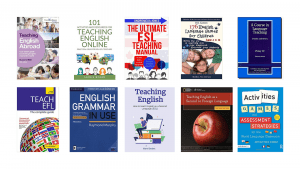Hiring a TEFL Teacher Who’s World-Class
Hiring a TEFL teacher is a big responsibility. But hiring someone you’ve never met in ‘real life’ and persuading them to fly halfway around the world to work for you is a huge responsibility. So how do you hire the right person? Through trial and error (mostly error), I taught myself the 12 steps to building a great team. So if you are looking to hire world-class teachers, don’t learn the hard way – just follow these 12 steps.
1. List your criteria
What qualities and qualifications would your ideal teacher have? Make a list of the hard skills (qualifications, level of English) but also the soft skills that you’re looking for. For me, teachers had to be adaptable (living in Bolivia isn’t for everyone!) and outgoing, if they were going to get on with our raucous students. Think about what kind of teacher will be able to flourish in your school environment. For example, in our case we were not able to provide a large salary – but we were able to provide lots of training and support. So we went on a search for a ‘diamond in the rough’. The ideal candidate did not have to be young, but they had to show flexibility, critical-thinking skills, and a passion for learning.
Your final list of essential traits for hiring a teacher for young learners might end up being something like this:
- CELTA (or equivalent) qualified
- Willing and able to live abroad
- Patient and understanding
- Creative
- Able to fit in with the team
- Keen to learn
2. Make a scoring matrix
So once you have your list, turn it into a scoring matrix. This means that you will be able to grade each candidate on a scale out of 100. This makes it easier to compare candidates against each other.
Your scoring system needs to include all of the qualities (or your version of them) listed in step 1, above. You can change the weighting of each essential trait in order to reflect its importance. In my case, I always strongly prioritised ‘ability to fit with the team’ because it does not matter how great a person is at teaching, if they are unable to fit in they can make their colleague’s life a nightmare, which in turn, harms morale. Below is an example of a grading template.

3. Write an outstanding job advert
Only when you have a very clear idea of what kind of person you are looking for should you write your job advert. Your job advert needs to be outstanding: it needs to catch the eye of exceptional candidates and speak directly to them. Think of what teachers are looking for in a job. Yes, obviously they want to get paid, but not many people become a teacher for the cold hard cash, and the few that do are not worth hiring. They probably want to live somewhere culturally interesting, have adventures and work with a friendly team. Maybe they want to have a positive impact on the lives of children or wish to develop as a teacher. Think about what your school can offer the teacher in terms of experience and write about that.
How will you look after them? Our school was unable to pay the highest wages (there is no way that an institute in Bolivia can compete with the salaries offered in the UAE or China) so, we emphasised that teachers would be in the heart of South America, and would be taken care of with free health insurance and offered help in finding suitable and safe accommodation.
At this point, you may well need to involve an employment and immigration lawyer. It pays to get the wording right as you do not want to end up on the wrong side of the law later on.
4.Post your job advert in the right places
The right job posting meant that I got hundreds of applications each time I published an advert. However, remember that you are looking for quality, not just quantity and that means posting to places where great ESL teachers hang out. Ideally, as a school director you will have social media contacts on LinkedIn who can help you to spread the word. If not, Dave’s ESL Cafe is a great place to place your job advertisement, as it is a popular hangout for ESL teachers and will directly target an ESL audience than you would attract on the more general job sites.
5. What to look for in a CV and cover letter
When the applications start rolling in, you may just have a minute or less to consider each applicant. The most important thing to consider is whether or not they have taken the time to apply to your school in particular, and not to just spam 100 schools with the same application. When a candidate starts their letter with ‘Dear Sir,’ I know they have not read my job advert carefully. The next thing I look for is whether they went above and beyond the expectations of their previous employers/schools. Maybe they taught in a primary school and during that time also started a drama club. Maybe they were involved in clubs in university or redesigned a process at their previous job. The quality you are looking for here is growth, are they someone who is capable of achieving more than they were hired to do? That kind of person is essential if your school is going to grow.
After looking at a CV, I put it in one of three piles; the ‘A’ pile for candidates I would definitely love to interview, a ‘B’ pile for backups and a ‘C’ pile for those who just do not seem like a good fit.
6. Respond to each applicant
Even if you do not hire someone, you want to give a good impression of yourself as an employer (a bad reputation is very difficult to work your way back from!) In essence, this means sending a courteous reply to every candidate. I have to admit – with the other pressures of running a school and teaching, I was not always good at this myself and it something I regret. Apart from anything else, it is horrible to apply for a job and never hear anything back. A simple reply to each candidate shows common courtesy and its costs nothing to be nice.
7. Base your interview around your scoring matrix
Plan a structured interview with questions based around the soft and hard skills you are looking for. For example, if you are looking for someone who is creative, find out if they have those skills by asking questions like ‘What do you enjoy doing in your spare time?’ (shopping is probably not the answer you’re looking for!), or ‘Tell me about a time when you had to find a creative solution to a problem at work’. As Frazer Scott, HR whizz at Twinkl points out, having a set set of questions also helps you to compare candidates more fairly.
Scott also suggests designing questions (and looking for responses) that follow the STAR structure: Situation, Task, Action, Result. For example: What was going on? What was your goal? What did you do to achieve that goal? How successful was it? That ability to follow through with a task and to reflect, will make for a great staff member.
As an added bonus, I also try to find out what candidates’ future goals are. Do they align with the company’s goals and what they can gain from this new position? Maybe they want to learn a foreign language – how will this new job help them achieve that goal? Aligning personal and company goals will make sure that your teacher stays motivated in their job.
After the interview, remember to reflect on the contributions you made. Did you allow the candidate to speak for the vast majority of the time, and to give you full answers? It is easier than you think for interviewers to accidentally dominate the conversation. Finally, make sure you are encouraging. Candidates are bound to be nervous – even the best ones – so give them your full attention and patience.
8. Try to track their logical thinking
Maybe this is just personal taste, but I really focus on whether a candidate can give a full, coherent answer to a question rather than just a waffle. I remember asking candidates for an office manager position, about times when they had successfully dealt with a difficult customer in their previous roles. About half of them told me long stories about difficult customers, but the end result was not good; they had completely ignored the important part of the question, which was how they successfully dealt with the difficult situation. Perhaps it is best to be mindful of this and to redirect candidates to the question you wish for them to answer.
A candidate who asks insightful questions about the job is also a winner. It shows that they have researched the school and the position – it is likely a good sign of someone who goes beyond the minimum requirements.
9. Be honest about working and living in the environment
When you are conducting your interview, you should also be super-honest about what the position entails. I always gave teachers the warning that Bolivia was not an easy country to work in and to live in and I point out that some people do not like it because it is so different to home. If you are hiring someone who would have to move countries, you need someone with a bit of ‘grit’ – someone who does not quit as soon as things get tough. If someone is not up to the job, then, your honesty about the actual reality of working and living in your particular area, will help them to decide if the job is actually for them.
10. Get a second opinion
So, you have maybe three or four great candidates. They aced the interview and have all of the qualities you are looking for. The next step is to get a second opinion by asking them to attend for a second round of interviews. At this point, I ask candidates to send along a lesson plan, and I also get a second (and often third) opinion. I often do the first round of interviews and then my two co-directors do the second. This gives a more well-rounded view – other people will pick up on aspects of a candidate that you may have been blinded to. Having a second interview and interviewer allows you to have a later discussion to challenge your assumptions on a candidate.
The second interview is when I ask candidates to prepare a lesson plan. This gives a chance to ask them some very specific questions about their way of thinking, their teaching style and their creativity. We send them along materials for the lesson, so a good test is to see how well they incorporate ideas or resources outside of the minimum we sent, and how engaging (and logical) they are.
11. Obtain their references
Yes, I know that people rarely get a bad reference. But, I think you can spot a great reference by looking at these two things which I feel are of importance: does it come across as honest? and does the previous employer respond quickly to your request?
12. Look after your teacher
The hiring process is just the first step in developing a great team. You have to put time and energy into helping new teachers to adapt to their new environment. This means taking time to listen to and to answer their questions. This means allowing them to be honest about their failures and problems – which they will inevitably have. If they can open up to you about difficulties in their job early on, you will be able to take corrective action to support them before an issue snowballs. And never lose sight of their personal goals, and try to think about how working with you can help to facilitate those goals. For example: if they want to learn a new language? Connect them to a great teacher – give them a room so they can have their lessons in your school.
I really, really hope that this article was useful to you in your search for new teachers. There is loads of support that Twinkl ESL can offer English language schools, and you can always connect with me on LinkedIn – I’m always up for answering your questions and hearing about your tips, too.






